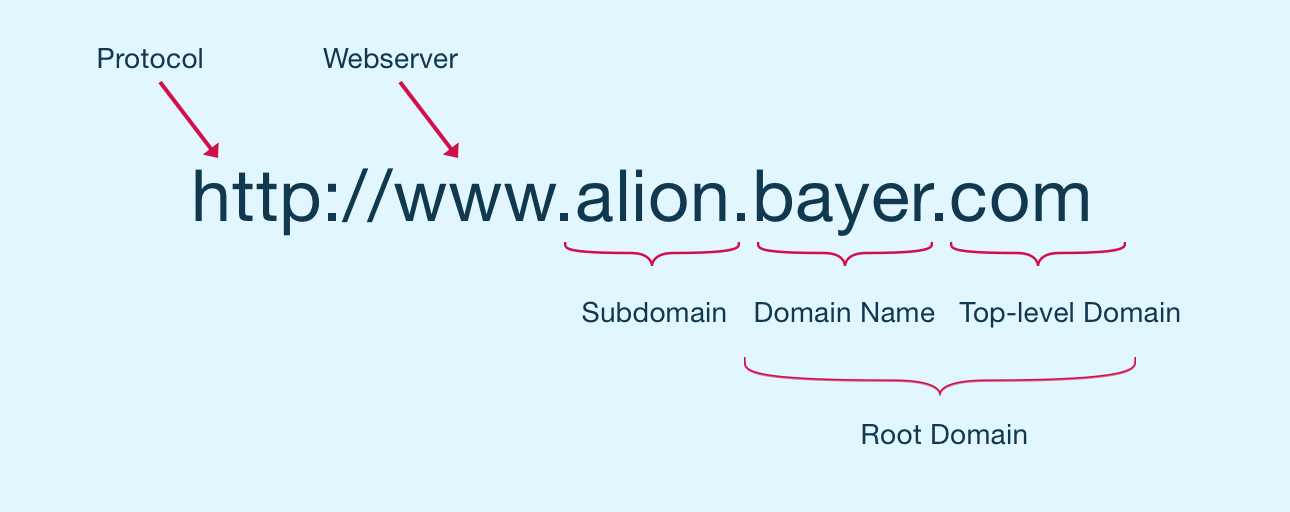Domain Naming Strategy
The domain naming strategy provides Bayer with a systematic, customer-oriented structure for naming domains, thus embodying our branding strategy of strengthening product brands and allying them with the umbrella brand on the web. As such, the domain name is one important element of the web presence. It’s the virtual company address on the Internet.
Domain names are subject to the provisions of trademark and competition law. Trademark disputes may arise when a domain name is reserved which conflicts with older intellectual property rights.
It is essential that we, on the one hand, protect our own trademark rights from unauthorized use by third parties and, on the other hand, ensures that the rights of third parties are not infringed through the reservation and use of domain names by Bayer. As such, Bayer must be the registered owner of all of its domain names at all times.
What are domains?
Domain names are the unique, human-readable Internet addresses of websites. They are made up of three parts:
- a top-level domain (sometimes called an extension or domain suffix),
- a domain name (or IP address), and
- an optional subdomain.

The combination of the domain name and top-level domain only is known as a “root domain.” The “http://” is part of a page URL but not its domain name and is known as the “protocol.”
Let’s look at each of these elements more closely:
Top-level domain
Top-level domain (TLD) is the formal term for the suffix that appears at the end of a domain name. Some examples of top-level domains are:
- .com
- .net
- .info
- .edu
While we are probably all familiar with the TLDs above, there are actually over 1,000 possible TLDs from which digital marketing managers can choose.
TLDs are often associated with specific countries or territories like
- .de (Germany)
- .uk (United Kingdom)
- .dk (Denmark)
- .us (America)
These country-specific TLDs are known as country code top-level domains, or ccTLDs.
Avoid hyphens and numbers
If your domain name has two words like [www].examplesite.com, you may want to separate the words with a hyphen for better readability: [www].example-site.com. However, keep in mind that use of hyphens also strongly correlates with spammy behavior and decreases domain name readability and memorability.
Search engines may see this as spam and this could have an impact on website rankings. Hyphens and numbers are also not user-friendly as they are not as memorable and may hurt direct traffic if customers misspell the URL and accidently land on a competitor’s site.
Using keywords for SEO
It’s perfect to use one of the business primary keywords in the domain name but also important to strike a balance and not spam the URL. Brainstorm five possible keywords and then add prefixes and suffixes to create good domain names. Keywords tell both customers and search engines what the website is about. If you are targeting a particular region, you may want to add your locality to improve local search rankings.
Choosing a brandable domain
There is some debate about how much value search engines like Google exactly place on keyword domain names when it comes to overall page rank. Having a domain name that matches the defined target keyword(s) does offer some benefits, but there is a bigger factor to consider: the brandability of the domain.
The brand is important, and the domain name is the foundation upon which online brands will be built. Domain name is how users will find, remember, share and identify our company online. In both social media and search engines, the domain name is the primary way by which customers can identify where the link will lead.
While some marketers think SEO is only about keywords and links, the reality is Google likes brands. Use Google’s keyword tool to find the exact match search volume for the keyword phrase the domain matches. Google CEO Eric Schmidt once said: “Brands are the solution, not the problem.”






